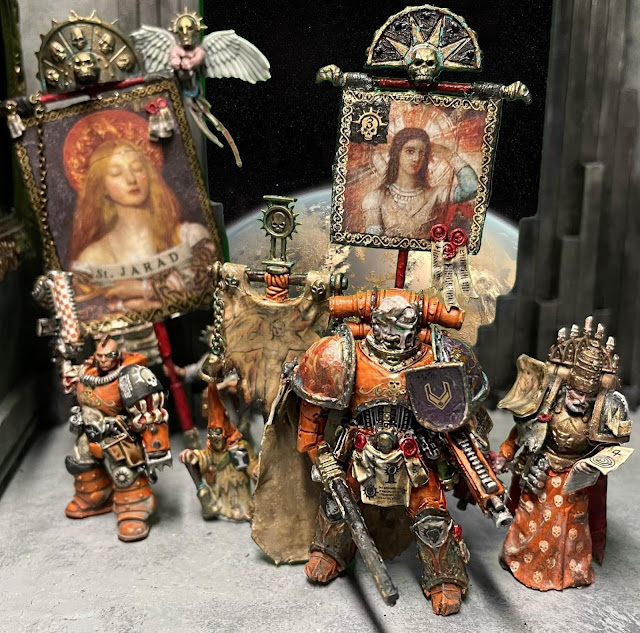Eikonography:
On the Great Statue of Sanguinius, heart of the Myrean Cluster
Tales of Primarchs
Divorcing the signal from the sign
'[D]epending on one's interpretation, and owing to the lamentable unwillingness of the Ordos to allow a physical examination, I can say only that [...] at least three or four distinct eras are represented in the figure and his attributions. Various elements have been added and removed at sundry times, ranging from the removal of the statue’s weapon and replacement with an Aquila standard soon after construction, all the way through to the decapitation of the standard 3 millennia later and its transformation into the Caputmori, an obscure symbol of some long-forgotten origin.'
'Sanguinius is rarely depicted thus; a muscular, defiant brute clutching a chain of trophy skulls, and it is my guess that at least part of the work is based on some primeval warrior-god of the region. As evidence, I point to the artistry of the wings and buckle of the teckije. Cleverly done, it shows a close approximation of the hammered, not cast, metal of the original, but telltale signs are clear to those with the wit to see.'
This is followed by a short breakdown of the specifics; in which Mnemos grants that areas at human head height (discounting the later pediment, the colossal statue is some fourteen foot tall), are frequently touched by pilgrims, leading to absrasion of the oxidised surface.
'[And so] to the amateur, one might suppose the part to be original – but my contention is simple. This statue has been considerably altered from the sculptor's intent, at distinct times. The style is clearly Terran Monolithic, an ancient and much-mimicked – but seldom mastered – approach in these benighted times. I estimate this valuable piece to date back all the way to the very earliest days of Imperium; possibly pre-dating the settlement of the planet (a conclusion that is, alas, impossible to verify without alchaemical analysis). [...] It was altered some two thousand years ago; seemingly twice in relatively quick succession – no more than a few decades between each. [...] Look to the wings and halo; stylistically quite distinct. It is possible that the understanding of Sanguinius was in flux during the period, and it was altered more substantially and then more subtly adjusted – though why that preposterous and anachronistic maul was associated with the Angel is unclear.'
On the identity of the underlying original figure, he has this to say:
'The scale of 'Sanguinius' gives little away; the Morqub region is notorious for exaggeration. Laughably, it is said a renegade Space Marine master once led his warband across the sector, pursued by Imperial forces. Believable enough, except that this 'Ulnusq Ouar' reportedly stood above 'two-and-a-half èrn' tall; a local measurement equivalent in height to one man on another's shoulders, far beyond even the biggest space marine. No; I find it more likely that this statue originally depicted another figure, perhaps even another Primarch – though the only extant script that might shed light on his identity is the interlaced and repeated 'infinity' symbol (or its like) across his gladiatorial dress.[...] Why such a figure would be substituted with Sanguinius is unclear, except that the Blessed Primarch is particularly beloved in the region.'
The extract continues:
'Fundamentally, then, we are left with a mystery. The statue of Sanguinius was likely originally another figure – and in my estimation an unknown Primarch. This only deepens the mystery, however, for while we might find innumerable explanations for why the original subject might be replaced, it leaves a gaping hole in our understanding and one fundamental question. Who was depicted in the brief period of a decade or two between the original sculpture being altered, and that alteration then being disguised as Sanguinius?'
***
 |
| [//Propitiation of Remonstrance+] [//@death_of_a_rubricist+] |
"What is he? You claim to want the truth, Inquisitor. But what truth, what proof could I bring that you would believe? Would you believe my word or data pics?
No, sometimes, truth is not about facts. Truth is a path you must walk on your own.
What is he? He is the seed of doubt, he is the seed of truth...."
[//Vox Volnoscere+]


